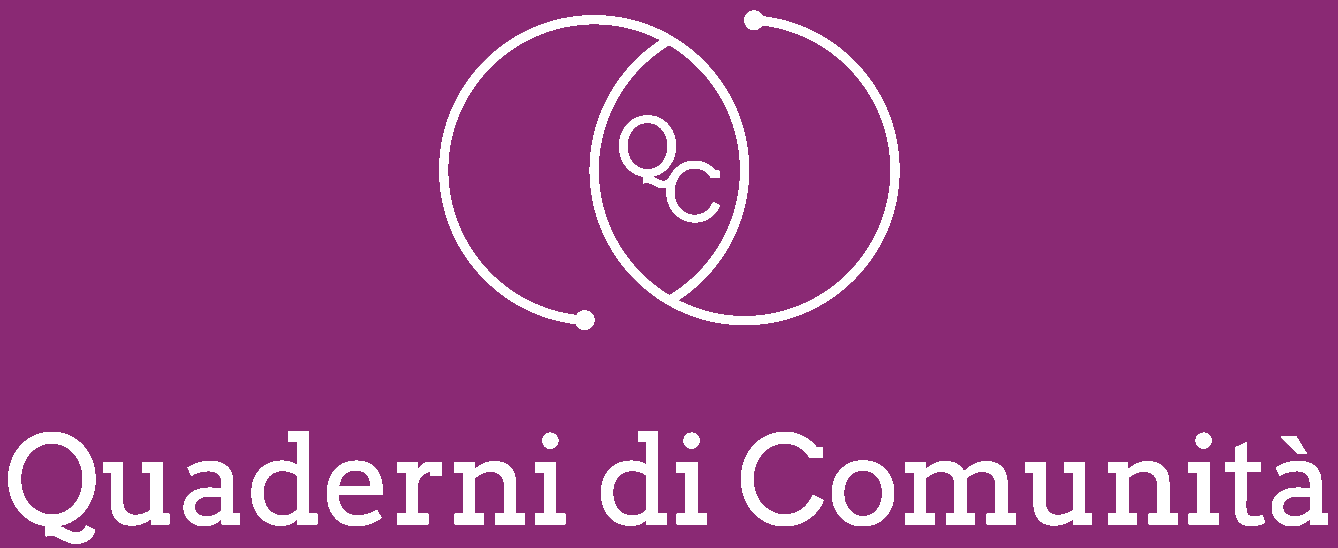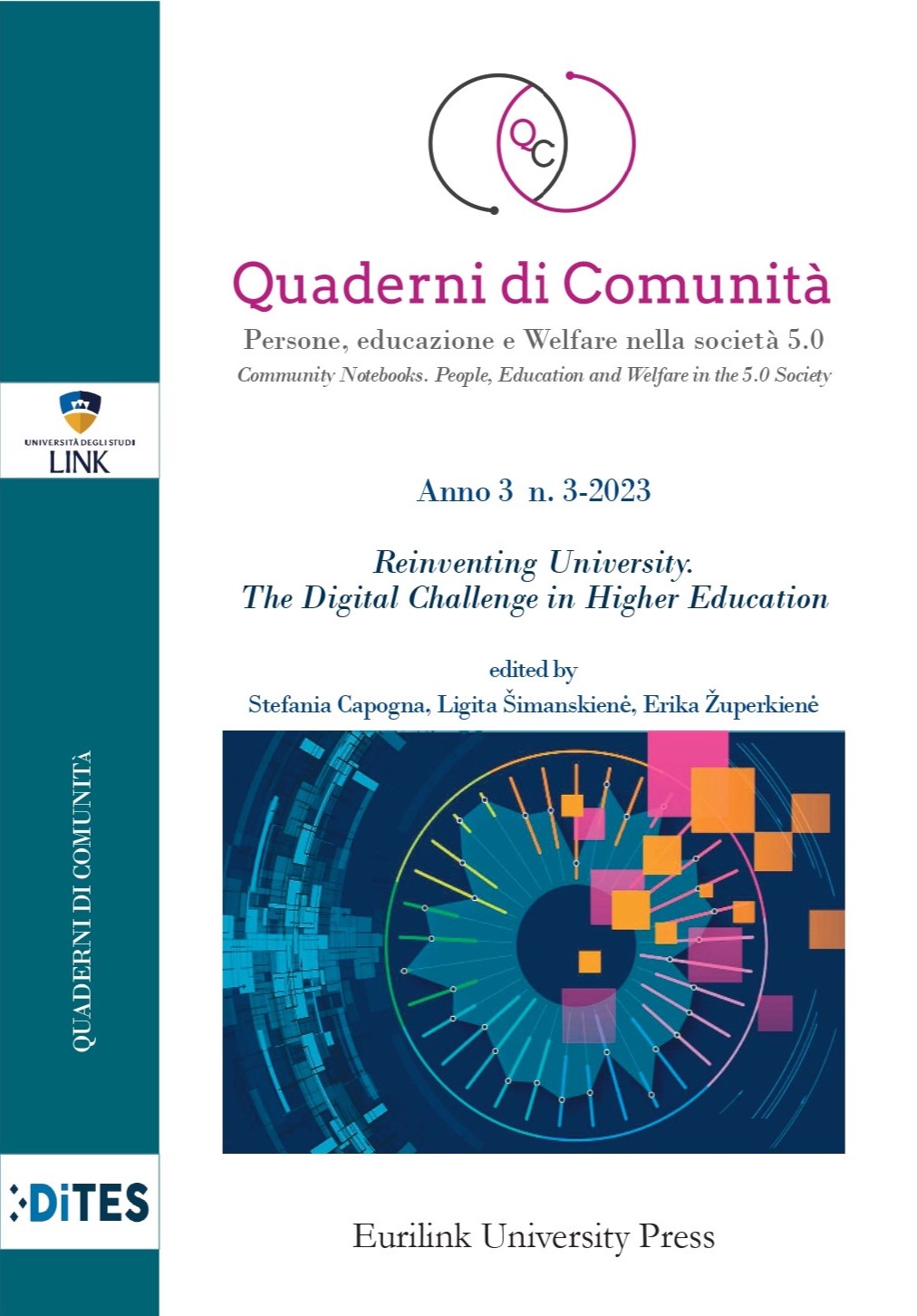Modernity and Identity processes on the light of the diffusion of new digital technologies
DOI:
https://doi.org/10.61007/QdC.2023.3.161Keywords:
Identity processes, modern society, new media, online ad offlineAbstract
This paper delves into the complex interplay among identity processes, modern society, and new media. Drawing from sociological theories, it commences with an examination of identity evolution in modern industrial societies, accentuating the proliferation of roles and statuses. The advent of digital technologies introduces complexity to individual choices, nurturing a malleable identity. The narrative then pivots to the transformative influence of Information and Communication Technologies (ICT), ushering in a global village. The emergence of Web 2.0 and 3.0 signifies pivotal updates, fostering user-generated content and reshaping societal interactions. The ongoing shifts in socialization processes due to economic, political, and cultural changes are scrutinized, with a spotlight on the instrumental role of digital media. The intricate process of identity formation amidst evolving socialization is explored, underscoring the morphostatic and morphogenetic functions of media. The interconnected nature of online and offline identity processes is dissected, emphasizing their symbiotic communication and coexistence. In conclusion, the paper underscores the seamless exchange between online and offline identities facilitated by the portability of devices. The overarching goal of this contribution is to provide a nuanced understanding of identity dynamics, weaving together insights from sociological theories and technological developments.
References
Baym, N. K. (1998). The emergence of on-line community in S. Jones (Ed.), Cybersociety 2.0: Revisiting computer-mediated communication and community (pp. 35-68). Thousand Oaks, CA: Sage.
Barak, A. (2008). Psychological aspects of cyberspace: theory, research, applications. Cambridge: Cambridge Univercity Press.
Barth, F. (1981). Process and form in social life, Routledge & Kegan Paul Books. London: Boston and Henley.
Bauman, Z. (2000). Liquid modernity, Cambridge, Polity Press.
Bauman, Z. (1998). On Glocalization: Or globalization for some, localization for some others. Thesis Eleven, No. 54, 1998, pp. 37- 49.
Beck, U. (1992) Risk society: towards a new modernity, (M. Ritter, Trans.). Los Angeles: SAGE. (Original work published 1986).
Besozzi, E. (2006). Società, cultura, educazione [Society, Culture, Education]. Roma: Carocci.
Boccia Altieri, G. (2012). Stati di connessione. pubblici, cittadini e consumatori nella network society [Connection states. public, citizens and consumers in the network society]. Milano: FrancoAngeli.
Boyd, D. (2014). It’s complicated. The social lives of networked teens. New Haven, CT: Yale university Press.
Bourdieu, P. (1972). Esquisse d’une théorie de la pratique: Précédé de « Trois études d’ethnologie kabyle». Genève, Suisse: Librairie Droz. doi:10.3917/droz.bourd.1972.01.
Campbell, C. (2005). The craft consumer: culture, craft and consumption in a postmodern society. Journal of Consumer Culture, 5 (1). pp. 23-42.
Caron, A., & Caronia, L. (2006). Cultures mobiles. Montreal: Editions De l’Université De Montreal.
Carr, N. (2010). Internet ci sta rendendo stupidi? come la rete sta cambiando il nostro cervello [Is internet making us stupid? how the net is changing our brain]. Milano: Raffaele Cortina Editore.
Castells, M., (2001). Internet Galaxy. Oxford: Oxford University Press.
Corradini, L. (1995). Essere scuola nel cantiere dell’educazione [Being a school in the building site of education]. Roma: SEAM.
Corsaro, W. A. (2003). Le culture dei bambini [Children Culture]. Bologna: Il Mulino.
Cortoni, I. (2011). Save the media. l’informazione sui minori come luogo comune [Save the media. information on youth as a common place]. Milano: FrancoAngeli.
Dahrendorf, R. (1980). Life chances: approaches to social and political theory. Chicago: University of Chicago Press. (Original work published 1979).
Donath, J. (1999). Identity and deception in virtual community in cyberspace, in M. Smith and P. Kollock, Communities in Cyberspace. New York: Routledge, pp. 29-59.
Donati, P. (1998). Lezioni di sociologia. Le categorie fondamentali per la comprensione della società [Sociology lessons. The fundamental categories for understanding the society]. Milano: CEDAM.
Durkheim, E. (1984). Thedivision of labor in society, (W. D. Halls, Trans). New York: Free Press. (Original work published 1893).
Eisenstadt, S. N. (2000). Multiple Modernities, in “Daedalus”, Winter 2000; Vol.129, N 1, Research Library Core, pp. 1-29.
Gallino, L. (1996). Manuale di sociologia [Handbook of sogiology]. Torino: UTET.
Giddens, A. (1992). The consequences of modernity. Cambridge: Polity Press. (Original work published 1991).
Giddens, A. (1999). Runaway World: How Globalisation is Shaping Our Lives. London: Profile. Books.
Giovagnoli, M. (2005). Fare cross media [Do cross media]. Roma: Editore Audino.
Goffman, E. (1956). The presentation of self in everyday life. Edinburg, University of Edinburg, Social Sciences Research Centre.
Graham, S., & Marvin, S., (2001). Splintering urbanism: Networked infrastructures, technological mobilities and the urban condition. London: Routledge.
Habermas, J. (1992). The philosophical discourse of modernity (Frederick G. Lawrence,Trans.). Cambridge: MIT Press. (Original work published 1985).
Himanen P. (2001). The Hacker Ethic and the Spirit of the Information Age. New York: Random House Inc.
Hine, C., (2000). Virtual ethnography. Sage Publications Ltd http://dx.doi.org/10.4135/9780857020277.
Innis, H. A. (1950). Empire and communications. Oxford: University of Oxford Press.
Innis, H. A. (1951). The bias of communication. Toronto: University of Toronto Press.
Ito, M. (2010). Hanging out, messing around, and geeking out. kids living and learning with new media. (Ma.), Cambridge: MIT Press.
Jameson, F. (1991). Postmodernism or, the cultural logic of late capitalism. Durham: Duke University Press. (Original work published 1989).
Jenkins, H. (2007). Reconsidering digital immigrants. Retrieved from http://henryjenkins.org/2007/12/reconsidering_digital_immigran.html.
Jenkins, R. (2000). Categorization: identity, social process and epistemology, Current Sociology, 48(7):7-25. https://doi.org/10.1177/0011392100048003003.
Jenkins, R. (2008) Social Identity. London: Routledge.
Kuhn, T. (1962). The structure of scientific revolutions. Chicago: Chicago University Press.
Lazzarini, G. (2004). Discrasia. Patologie di un rapido mutamento sociale [Dyscrasias. Pathologies of rapid social change]. Milano: Franco Angeli.
Livingstone, S. (2009). Children and the internet. Cambridge: Polity Press.
Lyotard, J. F. (1979). La Condition postmoderne. Rapport sur le savoir. Paris: Éditions de Minuit.
Lyotard, J. F. (1986). Le Postmoderne expliquéaux enfants. Paris: Editions Galilée.
Martelli, S. (2001). Videosocializzazione. Processi educativi e nuovi media [Video-socialization. educational processes and new media]. Milano: FrancoAngeli.
Marx, K. (1867). Das Kapital, Kritik Der Politischen Ökonomie I. Buch. Der produktionsprozess del Kapitals. Berlin: von der Rosa- Luxemburg-Stiftung.
Mcluhan, M. (1962). The Gutenberg Galaxy. The making of typographic man. Toronto: University of Toronto Press.
Mcluhan, M. (1964). Understanding media: the extensions of man. New York: Macmillan.
Mcluhan, M. (1967). The medium is the massage. London: Penguin Books.
Mcluhan, H. M. (1998). Media E Nuova Educazione. Il Metodo Della Domanda Nel Villaggio Globale; (E. Gandini Gamaler, Trans.). Roma: Armando.
Mead, G. H. (1934). Mind, self and society. Chicago: University of Chicago Press.
Merton, R. K. (1957). Social Structure and Anomie. In Social Theory and Social Structure. New York: Free Press.
Meyrowitz, O. (1985). No sense of place. The impact of electronic media on social behaviour. New York: Oxford University Press.
Missika, J.L. (2006). La Fin de la télévision. Paris: Seuil.
Morcellini, M. (1992). Passaggio al futuro, formazione e socializzazione tra vecchi e nuovi media [Transition to the future, training and socialization between old and new media]. Milano: FrancoAngeli.
Morcellini, M., & Cortoni, I. (2007). Provaci ancora scuola. Idee e proposte contro la svalutazione della scuola nel tecnoevo [Try again school. Ideas and proposals against the devaluation of the school in the tecnoevo]. Trento: Erickson.
Morin E., (1999). La téte bien faite. Repenser la réforme, réformer la pensée. Paris: Seuil.
Morin E., (2014). Enseigner à vivre. Manifeste pour changer l’éducation. Arles: Actes sud/Play bac.
Oksman, V., & Rautiainen, P. (2003). Perhaps it is a body part: how the mobile phone became an organic part of the everyday lives of finnish children and teenagers, in J. E. Katz,”Machines that become us: the social context of personal communication technology”. New Brunswick, NJ: Transaction Publishers, pp. 293- 308.
Ong, W. J. (1982). Orality and literacy. The technologizing of the word. London: Methuen.
O’Reilly, T. (2005). What is web 2.0 design patterns and business models for the next generation of software. Retrieved from http://www.oreilly.com/pub/a/web2/archive/what-is-web-20.html.
Prandstraller, S., 2008, La Soggettività Come Tecnologia Sociale. Un orientamento per le politiche [Subjectivity As Social Technology. An orientation for policies]. Milano: FrancoAngeli.
Prensky, M. (2001). Digital Natives, Digital Immigrants. Retrieved from Http://Www.Scribd.Com/Doc/9799/Prensky-Digital-Natives-Digital-Immigrants-Part1.
Reid, E. M. (1991). Electropolis: Communication and community on Internet Relay Chat. Unpublished master’s thesis, University of Melbourne. Retrieved from http://www.ee.mu.oz.au/papers/emr/electropolis.html (retrieved December 25, 1996).
Riva, G. (2008). Psicologia dei nuovi media [Psichology of new media]. Bologna: Il Mulino.
Riva, G. (2014). Nativi digitali. Crescere e apprendere nel mondo dei nuovi media [Digital natives. Grow and learn in the world of new media]. Bologna: Il Mulino.
Rivoltella, P.C. (2010). Il volto sociale di facebook [The social face of facebook], in D. Vinci, Il Volto Nel Pensiero Contemporaneo. Trapani: Il Pozzo Di Giacobbe.
Schutz, A. (1970). Reflections on the problem of relevance. New Haven & London: Yale University Press.
Sciolla, L. (2010). L’identità a più dimensioni. il soggetto e la trasformazione dei legami sociali [Plus Size Identity. The subject and the transformation of social ties]. Roma: Ediesse.
Sen, A. (1999). Development as freedom. Oxford: Oxford University Press.
Sen, A. (2005). The argumentative indian: writings on indian history, culture and identity. London: Penguin Books Ltd.
Siemens, G. (2004). Connettivism: A learning theory for the digital age. Retrieved from http://www.itdl.org/journal/jan_05/article01.htm.
Simmel, G. (1890). Über sociale Differenzierung: sociologische und psychologische Untersuchungen [About social differentiation: sociological and psychological investigations]. Leipzig: Duncker & Humblot.
Tonioni, F. (2011). Quando internet diventa una droga [When the internet becomes a drug]. Torino: Einaudi.
Tursi, A. (2007). Estetica dei nuovi media [Aesthetics of new media]. Milano: Costa & Nolan.
Turkle, S. (1995). Life on the screen: Identity in the age of the internet. New York: Simon & Shuster.
Turkle, S. (2011). Alone together why we expect more from technology and less from each other. New York: Basic Books.
Weber, M. (1905). Die Protestantische Ethik Und Der Geist Des Kapitalismus [The Protestant Ethic And The Spirit Of Capitalism]. Tubingen: JCB Mohr Verlag.
Weber, M. (1919). Wissenschaft Als Beruf [Science As a profession], Tubingen: JCB Mohr Verlag.
Wellman, B. (2001). The rise of networked individualism, in Community Networks Online, ed. Leigh Keeble. London: Taylor & Francis.
Wellman, B., & Haythornthwaite, C. (2002). The internet in everyday life: an introduction. Oxford: Blackwell Publishers.
Wittgenstein, L. (1922). Logisch-Philosophicus Abhandlung [Logical- Philosophicus essay]. London: Routledge & Kegan Paul.
Wright, R. (2000). Non-Zero: the logic of human destiny. New York: Pantheon.
Downloads
Published
How to Cite
Issue
Section
License
Copyright (c) 2023 Quaderni di comunità. Persone, Educazione e Welfare nella società 5.0

This work is licensed under a Creative Commons Attribution-NonCommercial-NoDerivatives 4.0 International License.







